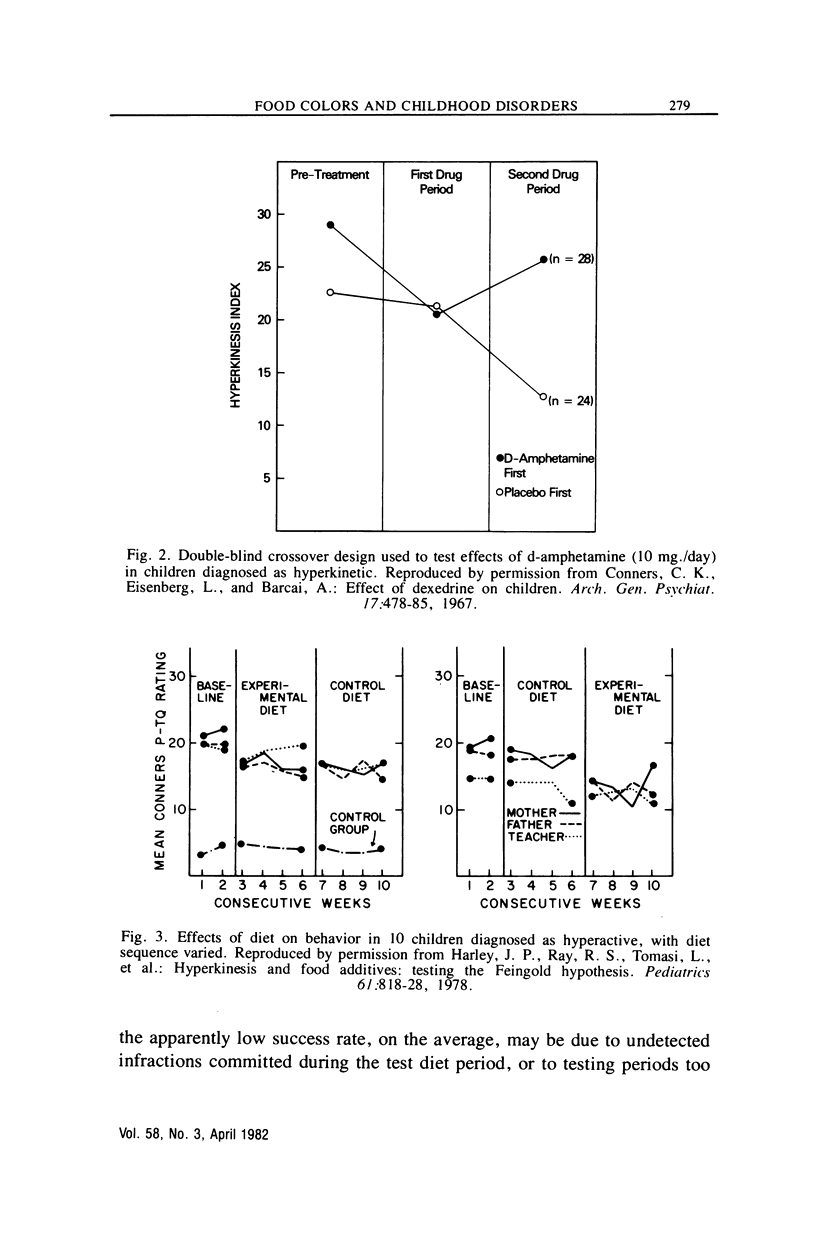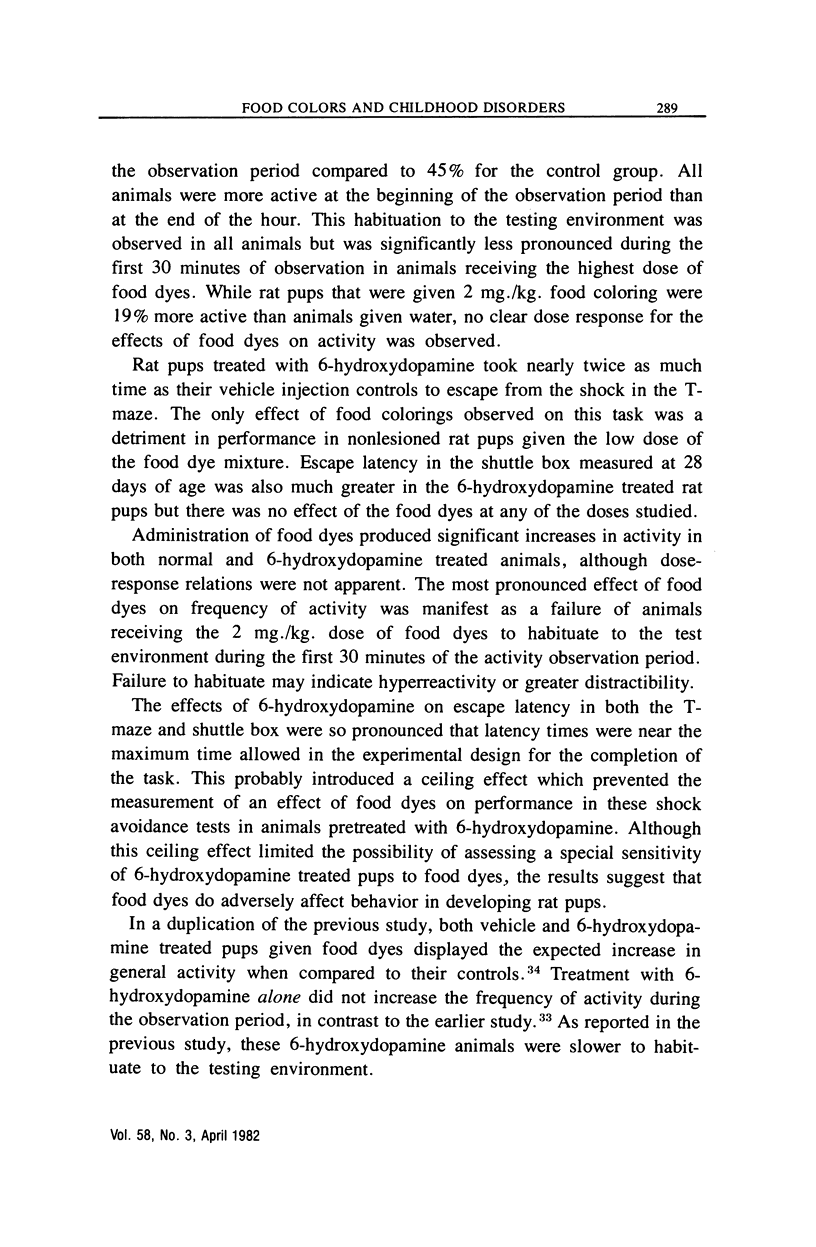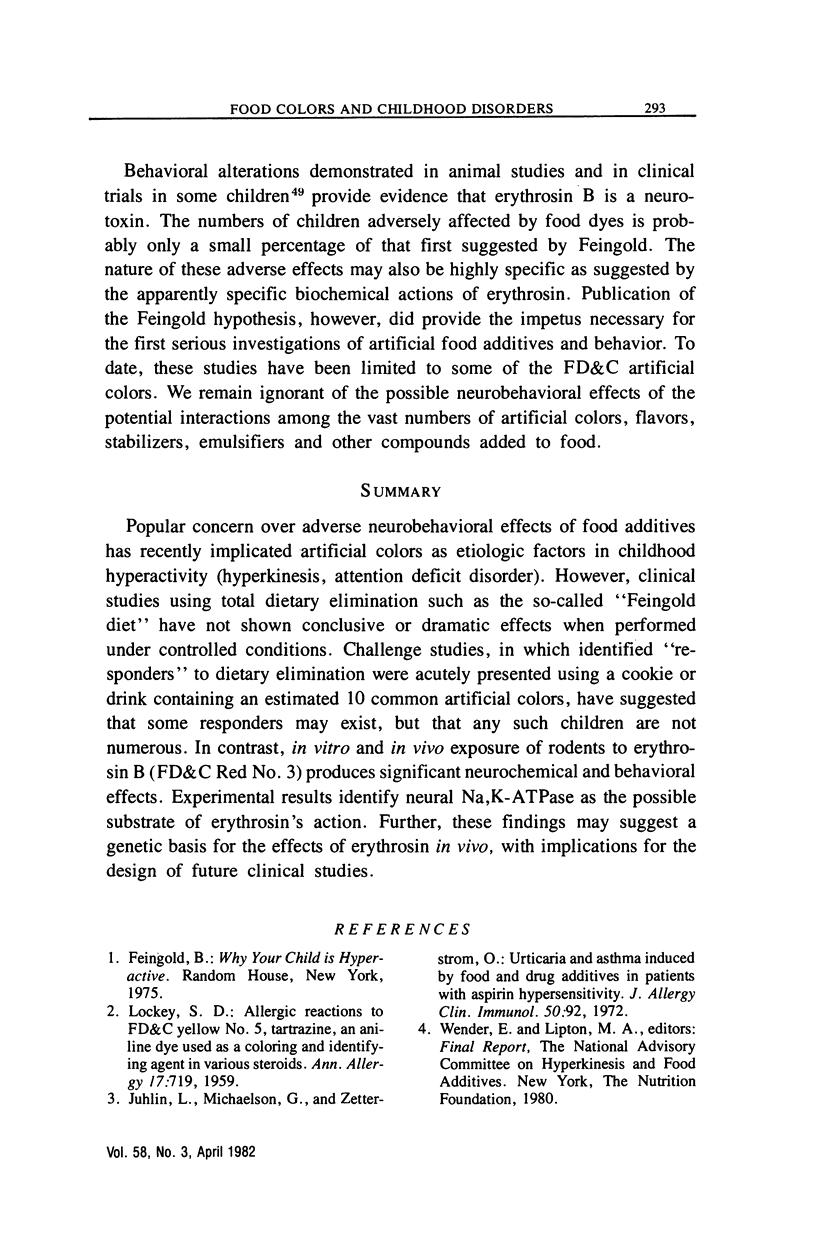Full text
PDF




















Selected References
These references are in PubMed. This may not be the complete list of references from this article.
- Augustine G. J., Jr, Levitan H. Neurotransmitter release from a vertebrate neuromuscular synapse affected by a food dye. Science. 1980 Mar 28;207(4438):1489–1490. doi: 10.1126/science.6244619. [DOI] [PubMed] [Google Scholar]
- Cantwell D. P. Psychiatric illness in the families of hyperactive children. Arch Gen Psychiatry. 1972 Sep;27(3):414–417. doi: 10.1001/archpsyc.1972.01750270114018. [DOI] [PubMed] [Google Scholar]
- Coleman M. Serotonin concentrations in whole blood of hyperactive children. J Pediatr. 1971 Jun;78(6):985–990. doi: 10.1016/s0022-3476(71)80428-6. [DOI] [PubMed] [Google Scholar]
- Conners C. K., Goyette C. H., Southwick D. A., Lees J. M., Andrulonis P. A. Food additives and hyperkinesis: a controlled double-blind experiment. Pediatrics. 1976 Aug;58(2):154–166. [PubMed] [Google Scholar]
- Corsaro C. M., Migeon B. R. Gene expression in euploid human hybrid cells: ouabain resistance is codominant. Somatic Cell Genet. 1978 Sep;4(5):531–540. doi: 10.1007/BF01542924. [DOI] [PubMed] [Google Scholar]
- Goldenring J. R., Wool R. S., Shaywitz B. A., Batter D. K., Cohen D. J., Young J. G., Teicher M. H. Effects of continuous gastric infusion of food dyes on developing rat pups. Life Sci. 1980 Nov 17;27(20):1897–1904. doi: 10.1016/0024-3205(80)90436-1. [DOI] [PubMed] [Google Scholar]
- Juhlin L., Michaëlsson G., Zetterström O. Urticaria and asthma induced by food-and-drug additives in patients with aspirin hypersensitivity. J Allergy Clin Immunol. 1972 Aug;50(2):92–98. doi: 10.1016/0091-6749(72)90004-8. [DOI] [PubMed] [Google Scholar]
- LOCKEY S. D. Allergic reactions due to F D and C Yellow No. 5, tartrazine, an aniline dye used as a coloring and identifying agent in various steroids. Ann Allergy. 1959 Sep-Oct;17:719–721. [PubMed] [Google Scholar]
- Lafferman J. A., Silbergeld E. K. Erythrosin B inhibits dopamine transport in rat caudate synaptosomes. Science. 1979 Jul 27;205(4404):410–412. doi: 10.1126/science.451609. [DOI] [PubMed] [Google Scholar]
- Lafferman J. A., Silbergeld E. K. Erythrosin B inhibits dopamine transport in rat caudate synaptosomes. Science. 1979 Jul 27;205(4404):410–412. doi: 10.1126/science.451609. [DOI] [PubMed] [Google Scholar]
- Levitan H. Food, drug, and cosmetic dyes: biological effects related to lipid solubility. Proc Natl Acad Sci U S A. 1977 Jul;74(7):2914–2918. doi: 10.1073/pnas.74.7.2914. [DOI] [PMC free article] [PubMed] [Google Scholar]
- Levy F., Dumbrell S., Hobbes G., Ryan M., Wilton N., Woodhill J. M. Hyperkinesis and diet: a double-blind crossover trial with a tartrazine challenge. Med J Aust. 1978 Jan 28;1(2):61–64. [PubMed] [Google Scholar]
- Logan W. J., Swanson J. M. Erythrosin B inhibition of neurotransmitter accumulation by rat brain homogenate. Science. 1979 Oct 19;206(4416):363–364. doi: 10.1126/science.39341. [DOI] [PubMed] [Google Scholar]
- Mailman R. B., Ferris R. M., Tang F. L., Vogel R. A., Kilts C. D., Lipton M. A., Smith D. A., Mueller R. A., Breese G. R. Erythrosine (Red No. 3) and its nonspecific biochemical actions: what relation to behavioral changes? Science. 1980 Feb 1;207(4430):535–537. doi: 10.1126/science.7352264. [DOI] [PubMed] [Google Scholar]
- Marks M. J., Seeds N. W. A heterogeneous ouabain-ATPase interaction in mouse brain. Life Sci. 1978 Dec 31;23(27-28):2735–2744. doi: 10.1016/0024-3205(78)90654-9. [DOI] [PubMed] [Google Scholar]
- Morrison J. R., Stewart M. A. A family study of the hyperactive child syndrome. Biol Psychiatry. 1971;3(3):189–195. [PubMed] [Google Scholar]
- Morrison J. R., Stewart M. A. The psychiatric status of the legal families of adopted hyperactive children. Arch Gen Psychiatry. 1973 Jun;28(6):888–891. doi: 10.1001/archpsyc.1973.01750360098015. [DOI] [PubMed] [Google Scholar]
- O'Fallon J. V., Brosemer R. W., Harding J. W. The Na+,K+-ATPase: a plausible trigger for voltage-independent release of cytoplasmic neurotransmitters. J Neurochem. 1981 Feb;36(2):369–378. doi: 10.1111/j.1471-4159.1981.tb01604.x. [DOI] [PubMed] [Google Scholar]
- Rutledge C. O. Effect of metabolic inhibitors and ouabain on amphetamine- and potassium-induced release of biogenic amines from isolated brain tissue. Biochem Pharmacol. 1978 Feb 15;27(4):511–516. doi: 10.1016/0006-2952(78)90386-6. [DOI] [PubMed] [Google Scholar]
- Safer D. J. "A familial factor in minimal brain dysfunction. Behav Genet. 1973 Jun;3(2):175–186. doi: 10.1007/BF01067657. [DOI] [PubMed] [Google Scholar]
- Schwartz A., Lindenmayer G. E., Allen J. C. The sodium-potassium adenosine triphosphatase: pharmacological, physiological and biochemical aspects. Pharmacol Rev. 1975 Mar;27(01):3–134. [PubMed] [Google Scholar]
- Shaywitz B. A., Yager R. D., Klopper J. H. Selective brain dopamine depletion in developing rats: an experimental model of minimal brain dysfunction. Science. 1976 Jan 23;191(4224):305–308. doi: 10.1126/science.942800. [DOI] [PubMed] [Google Scholar]
- Silbergeld E. K. Erythrosin B is a specific inhibitor of high affinity 3H-quabain binding and ion transport in rat brain. Neuropharmacology. 1981 Jan;20(1):87–90. doi: 10.1016/0028-3908(81)90048-4. [DOI] [PubMed] [Google Scholar]
- Silbergeld E. K. Erythrosin B is a specific inhibitor of high affinity 3H-quabain binding and ion transport in rat brain. Neuropharmacology. 1981 Jan;20(1):87–90. doi: 10.1016/0028-3908(81)90048-4. [DOI] [PubMed] [Google Scholar]
- Snyder S. H. Putative neurotransmitters in the brain: selective neuronal uptake, subcellular localization, and interactions with centrally acting drugs. Biol Psychiatry. 1970 Oct;2(4):367–389. [PubMed] [Google Scholar]
- Swanson J. M., Kinsbourne M. Food dyes impair performance of hyperactive children on a laboratory learning test. Science. 1980 Mar 28;207(4438):1485–1487. doi: 10.1126/science.7361102. [DOI] [PubMed] [Google Scholar]
- Sweadner K. J. Two molecular forms of (Na+ + K+)-stimulated ATPase in brain. Separation, and difference in affinity for strophanthidin. J Biol Chem. 1979 Jul 10;254(13):6060–6067. [PubMed] [Google Scholar]
- Valenzeno D. P., Pooler J. P. Phototoxicity. The neglected factor. JAMA. 1979 Aug 3;242(5):453–454. doi: 10.1001/jama.242.5.453. [DOI] [PubMed] [Google Scholar]
- Vizi E. S. Na+-K+-activated adenosinetriphosphatase as a trigger in transmitter release. Neuroscience. 1978;3(4-5):367–384. doi: 10.1016/0306-4522(78)90040-4. [DOI] [PubMed] [Google Scholar]
- Weissman B., Stanbridge E. J. Characterization of ouabain resistant, hypoxanthine phosphoribosyl transferase deficient human cells and their usefulness as a general method for the production of human cell hybrids. Cytogenet Cell Genet. 1980;28(4):227–239. doi: 10.1159/000131536. [DOI] [PubMed] [Google Scholar]
- Willerman L. Activity level and hyperactivity in twins. Child Dev. 1973 Jun;44(2):288–293. [PubMed] [Google Scholar]


